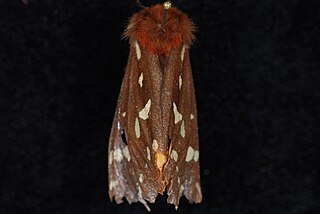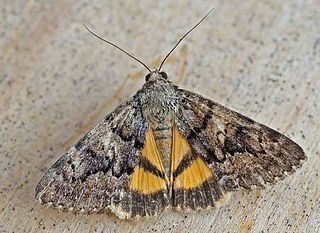
The Hepialidae are a family of insects in the lepidopteran order. Moths of this family are often referred to as swift moths or ghost moths.

Phymatopus is a genus of moths of the family Hepialidae, which consists of around 500 species and 30 genera. The genus was erected by Hans Daniel Johan Wallengren in 1869. They can be found across Eurasia and North America. Species can be distinguished by the different morphology of male genitalia and different forewing patterns, which vary in stripe colour and size and arrangement of spots. The stripes themselves consist of spots separated by dark veins which are fringed by thin black lines from both inner and outer sides.

Acerbia is a genus of tiger moths in the family Erebidae.

Palearctia is a genus of tiger moths in the family Erebidae.

Platarctia is a genus of tiger moths in the family Erebidae described by Packard in 1864.

Catocala nymphaea is a species of moth of the family Erebidae. It was described by Eugenius Johann Christoph Esper in 1787. It is found in southern France, Austria, Albania, Portugal, Italy, Greece, Corsica, Sicily, Crete, North Africa, Anatolia, Afghanistan and Kashmir.

Watsonarctia is a monotypic moth genus in the subfamily Arctiinae erected by Josef J. de Freina and Thomas Joseph Witt in 1984. Its only species, Watsonarctia deserta, the chaste pellicle, was first described by Max Bartel in 1902. It is found in central and south-eastern Europe, southern Russia, southern Siberia east to Lake Baikal; also in Asia Minor, Armenia, Azerbaijan, northern Iran, Kazakhstan, Kyrghyzstan and Xinjiang in China.
Anthracia is a genus of moths of the family Noctuidae. The genus was erected by Jacob Hübner in 1823.

Pseudopanolis is a genus of moths of the family Noctuidae.

Gynaephora is a genus of "tussock moths", also known as the Lymantriinae, within the family Erebidae. They are mainly found in the Holarctic in alpine, Arctic and Subarctic regions, and are best known for their unusually long larval development period. The life-cycle of Gynaephora groenlandica was once believed to take fourteen years, but subsequent studies reduced it to seven, still a very slow development rate that is extremely rare in the Lepidoptera. The caterpillars have five instars, with each instar lasting a year.
Antarchaea erubescens is a species of moth of the family Noctuidae first described by Andreas Bang-Haas in 1910. It is found from Morocco to the Arabian Peninsula southern Iran and Afghanistan.
Drasteria kabylaria is a moth of the family Erebidae first described by Andreas Bang-Haas in 1906. It is found from the western and central parts of the Sahara, to the Arabian Peninsula, Jordan, Sinai, south to Oman.

Catocala moltrechti is a moth of the family Erebidae first described by Otto Bang-Haas in 1927. It is found in south-eastern Siberia.
Heliosia rufa is a moth of the family Erebidae. It was described by John Henry Leech in 1890. It is found in the Russian Far East (Primorye) and China.
Oroncus ladakensis is a moth of the family Erebidae. It was described by Otto Bang-Haas in 1927. It is found in Tibet and Xinjiang in China.
Sibirarctia buraetica is a moth in the family Erebidae. It was described by Otto Bang-Haas in 1927. It is found in Russia and Mongolia.
Palearctia glaphyra is a moth in the family Erebidae. It was described by Eduard Friedrich Eversmann in 1843. It is found in eastern Kazakhstan, Kyrgyzstan, the central Tien Shan and China (Xinjiang).
Palearctia marxi is a moth in the family Erebidae. It was described by Otto Bang-Haas in 1927. It is found in Himachal Pradesh, India.
Catocala danilovi is a moth in the family Erebidae first described by Otto Bang-Haas in 1927. It is found in south-eastern Siberia.
Gynaephora rossii, in English known as Ross' tussock moth, is a species of tussock moth in the family Erebidae. It is widespread in the tundras and highlands of the Holarctic. It has large, furry caterpillars which seem to eat mostly saxifrages.









